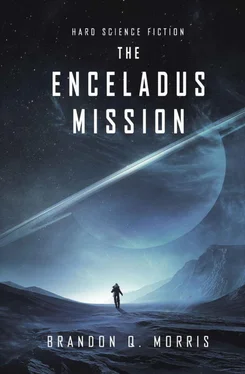The Orbit of Enceladus around Saturn
Enceladus is the sixth largest moon of the ringed planet Saturn, and it was also the sixth Saturn moon to be discovered. Today, a total of 62 Saturn moons are known. Counted from the center of the Saturn system, Enceladus is the fourteenth moon, though in the classical numbering system, it was the second. Therefore, it received the designation Saturn II by the International Astronomical Union. With an average diameter of 505 kilometers—about the distance from New York to Pittsburgh as the crow flies—Enceladus is considerably smaller than Earth’s moon, which has a diameter of 3,475 kilometers, though among all the moons of the solar system, it still ranks as the seventeenth largest. It is the ‘average’ diameter, because the gravitational pull of Saturn flattens this moon slightly, by about three percent. This shape is called an ellipsoid.
Enceladus cannot be observed from Earth with the naked eye. Its apparent brightness is at 11.8 apparent magnitude, and the human eye can see an object—under ideal conditions—up to a value of 6.
Its orbit around the planet is an almost perfect circle. The average orbital radius lies at about 238,000 kilometers. This puts Enceladus very close to its mother planet, which will be important for understanding the processes in its interior. The orbit of Earth’s moon is about 50 percent larger. In addition, Saturn is huge compared to Earth. The distance from Enceladus to the ‘surface’ of the planet is only slightly below 180,000 kilometers, and Saturn has about 95 times the mass of Earth, and therefore 95 times the gravitational pull.
This strong gravity has several effects on Enceladus, including on its orbit. Over millions of years, it caused the moon to always face the planet with the same side, something called ‘captured rotation.’ If you land on the back side of Enceladus you will never see Saturn, while from the planet’s perspective you could only see the ‘front side’ of Enceladus. This is also the relationship between Earth and its moon.
Like almost all of the moons of Saturn, as well as the rings, Enceladus orbits Saturn in a plane parallel to the equator of the planet. This is at an angle of about 27 degrees to the plane in which the planets move around the sun—the ecliptic plane. The orbit of Enceladus is also influenced by its siblings, which sometimes get very close to it. The orbit of Pallene, for example, the next moon closer to Saturn, is approximately 26,000 kilometers away, while the next moon further out, Tethys, has a distance of almost 57,000 kilometers. The tidal forces created by this interaction compel the moons into a kind of cosmic ballet. Dione, which is more than twice as large, is in a 2:1 orbital resonance with Enceladus. This means that for every two orbital periods Enceladus completes, Dione will finish one. With Mimas, which is further inward and a bit smaller, Enceladus is linked in a 3:2 resonance. And with the already mentioned moon Tethys, which is twice its size, Enceladus has agreed on a 4:3 orbital resonance.
For one orbit around Saturn, Enceladus needs one Earth day, plus an additional eight hours and 53 minutes. It orbits at a velocity of 12.64 kilometers per second. Therefore, Enceladus is twelve times as fast as our moon orbiting Mother Earth. The reason for this is not the laziness of Earth’s moon, but rather the much stronger pull of Saturn on Enceladus. If Enceladus were as slow as our moon, it would have ceased to exist a long time ago. Our moon, on the other hand, would have quickly escaped the vicinity of Earth if it orbited as fast as Enceladus.
By now you know how slowly Enceladus rotates. As it always shows Saturn the same side, it finishes exactly one rotation during an orbital period. The axis around which Enceladus rotates is exactly perpendicular to its orbital plane. Therefore, Saturn can always be seen at the same location in the sky over Enceladus. The rotational axis of Earth, on the other hand, is tilted toward its orbital plane around the sun—otherwise, Earth would have no seasons.

White and Cold: The Surface
There is a simple reason for the fact, as mentioned in the introduction, that Enceladus reflects light so well. The moon is completely covered with ice, perfectly normal ice as we all know it, i.e. water ice. This reflects light even better than freshly fallen snow on Earth. Enceladus is therefore often called an ‘ice moon,’ even though that is not literally true, as we will see in the next section.
This fact has some practical consequences for anyone traveling to Enceladus. You might know this from clear winter days—light reflected from the surface cannot warm the surface. Not only is this moon already at an enormous distance from the sun (more than 1.4 billion kilometers), but the high albedo (reflectivity) causes it to be even colder on Enceladus than the distance from the sun would make it. On the surface of its sibling, Dione, which has an albedo of 55 percent, i.e. much darker, the temperatures can reach minus 187 degrees Celsius, whereas on Enceladus the ‘warmest’ is only minus 200 degrees.
Even though the landscape on the surface is completely white, there are some variations. Plains (planitia, plural form planitiae) alternate with ridges 500 to 2,000 meters high (dorsum, plural dorsa), and both can contain trenches (sulcus, plural sulci), depressions (fossa, plural fossae) and cliffs (rupe, plural rupes), or be covered to some extent with craters.
If you try to find your way around Enceladus with a map, you might get the impression you are in the Arabian Nights . This is because the International Astronomical Union (IAU) decided to use geographical names from this famous work of world literature for this moon—except for the craters, which are named after protagonists from these stories.
Geologically speaking, the plains on Enceladus are very young. You can see that they—for example, the Sarandib Plain—contain far fewer craters than one would expect on a moon. It is estimated that many of its plains are less than a couple of hundred million years old. The impact craters, as the photos taken by the Cassini probe show, are in various stages of aging. While the climate on Earth makes craters wear away, and on Earth’s moon they are destroyed by new impacts, on Enceladus shifting of the ice erodes the craters.
The trenches and canyons are witnesses to this activity, and they can be up to 200 kilometers long, 5 to 10 kilometers wide, and up to 1,000 meters deep. They often cut through other geological features, so one must assume that they are relatively new phenomena. On Earth, rocky continental plates collide, but on Enceladus it seems to be ice plates. This sometimes creates cliffs up to 1,000 meters high.

Chaos in the South
The area around the South Pole of Enceladus plays a special role. Even in the pictures taken by Voyager 2 , scientists discovered a chaotic terrain, a mixture of very different terrains. Since the Cassini probe sent its spectacular images, we know a lot more. The area reaching up to 60 degrees southern latitude (about the position of Tierra del Fuego on Earth) is characterized by fractures and cliffs, but it contains even fewer craters than the rest of the moon. The surface must therefore be far younger. Scientists estimate it to be an average of 500,000 years old. Geologically speaking, that is very young.
From above, the center of this region looks particularly chaotic. Besides the fractures and plates, there are also giant ice boulders measuring 10 to 100 meters. The area is dominated by four fractures with a depth of up to 300 meters, the so-called Tiger Stripes, each of which is several hundred kilometers long. Pictures show that the ice at their edges has a considerably different composition from the ice on the regular plains. Organic compounds have been found here.
Читать дальше













